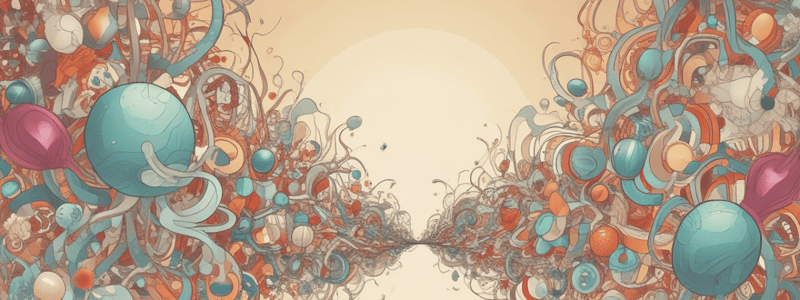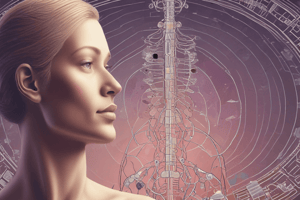Podcast
Questions and Answers
What is the half-life of insulin in plasma under normal conditions?
What is the half-life of insulin in plasma under normal conditions?
- 10-15 minutes
- 1-2 minutes
- 3-5 minutes (correct)
- 30-60 minutes
Which of the following organs are involved in insulin metabolism?
Which of the following organs are involved in insulin metabolism?
- Kidney and pancreas
- Liver, kidney and placenta (correct)
- Liver and kidney
- Pancreas and liver
What is the mechanism of insulin metabolism?
What is the mechanism of insulin metabolism?
- Insulin specific proteases and glutathione-insulin transhydrogenase (correct)
- Insulin specific proteases only
- Glutathione-insulin transhydrogenase only
- None of the above
What is the function of glucagon?
What is the function of glucagon?
Where is glucagon synthesized?
Where is glucagon synthesized?
How is glucagon inactivated?
How is glucagon inactivated?
What is formed when proinsulin and insulin combine with zinc?
What is formed when proinsulin and insulin combine with zinc?
What is released into the extracellular fluid when mature granules fuse with the plasma membrane?
What is released into the extracellular fluid when mature granules fuse with the plasma membrane?
Why may a radioimmunoassay for 'insulin' occasionally overestimate the bioactivity of 'insulin' presence in plasma?
Why may a radioimmunoassay for 'insulin' occasionally overestimate the bioactivity of 'insulin' presence in plasma?
What is the location of the human insulin gene?
What is the location of the human insulin gene?
What is the primary physiological regulator of insulin secretion?
What is the primary physiological regulator of insulin secretion?
Which of the following hormones increases insulin secretion?
Which of the following hormones increases insulin secretion?
How much insulin does the human pancreas secrete daily?
How much insulin does the human pancreas secrete daily?
What is a characteristic of insulin metabolism?
What is a characteristic of insulin metabolism?
What is the typical time frame for the onset of ketoacidosis in patients with type 1 diabetes after withdrawing exogenous insulin therapy?
What is the typical time frame for the onset of ketoacidosis in patients with type 1 diabetes after withdrawing exogenous insulin therapy?
What is the typical age range for the onset of type 1 diabetes?
What is the typical age range for the onset of type 1 diabetes?
What triggers the autoimmune attack on pancreatic β-Cells in type 1 diabetes?
What triggers the autoimmune attack on pancreatic β-Cells in type 1 diabetes?
What is the usual duration of the process of β-Cell destruction in type 1 diabetes?
What is the usual duration of the process of β-Cell destruction in type 1 diabetes?
What is the effect of an intercurrent illness on the onset of type 1 diabetes?
What is the effect of an intercurrent illness on the onset of type 1 diabetes?
What is the result of the autoimmune attack on pancreatic β-Cells in type 1 diabetes?
What is the result of the autoimmune attack on pancreatic β-Cells in type 1 diabetes?
What is associated with a high prevalence of type 1 diabetes?
What is associated with a high prevalence of type 1 diabetes?
What accounts for about half the genetic risk of type 1 diabetes?
What accounts for about half the genetic risk of type 1 diabetes?
What is the role of copper ions in dopamine β-monooxygenase?
What is the role of copper ions in dopamine β-monooxygenase?
What is the source of the hydroxyl oxygen in dopamine β-monooxygenase?
What is the source of the hydroxyl oxygen in dopamine β-monooxygenase?
What is the initial and rate-limiting step in the synthesis of dopamine, norepinephrine, and epinephrine?
What is the initial and rate-limiting step in the synthesis of dopamine, norepinephrine, and epinephrine?
What is the function of Phenylethanolamine N-methyltransferase (PNMT)?
What is the function of Phenylethanolamine N-methyltransferase (PNMT)?
What is the primary metabolite of norepinephrine?
What is the primary metabolite of norepinephrine?
What is the enzyme responsible for the metabolism of DHPG?
What is the enzyme responsible for the metabolism of DHPG?
What is the predominant metabolite of norepinephrine in human CSF?
What is the predominant metabolite of norepinephrine in human CSF?
What is the therapeutic strategy for the treatment of depression?
What is the therapeutic strategy for the treatment of depression?
What is the neurotransmitter released at the surface of the adrenal medullary chromaffin cell?
What is the neurotransmitter released at the surface of the adrenal medullary chromaffin cell?
What is the effect of estrogens on Tyrosine concentration?
What is the effect of estrogens on Tyrosine concentration?
What is the primary function of the Substantia Nigra region in the brain?
What is the primary function of the Substantia Nigra region in the brain?
What is the role of Dopamine produced in the Adrenal Medulla?
What is the role of Dopamine produced in the Adrenal Medulla?
What is the precursor for the synthesis of catecholamines?
What is the precursor for the synthesis of catecholamines?
What is the role of Ventral Tegmental Area (VTA) in the brain?
What is the role of Ventral Tegmental Area (VTA) in the brain?
What is the result of the activation of the acetylcholine receptor on the chromaffin cell?
What is the result of the activation of the acetylcholine receptor on the chromaffin cell?
What is the role of Tyrosine in the body?
What is the role of Tyrosine in the body?
Flashcards are hidden until you start studying
Study Notes
Insulin and Proinsulin
- Insulin and proinsulin combine with zinc to form hexamers.
- Upon stimulation, mature granules fuse with the plasma membrane and release insulin and C-peptide into the extracellular fluid.
- Proinsulin has a longer plasma half-life than insulin, which can lead to an overestimation of insulin bioactivity in radioimmunoassays.
- C-peptide has no known biological role, but its immunoassay can distinguish between endogenous and exogenous insulin and quantify the former when anti-insulin antibodies are present.
Insulin Secretion and Regulation
- Insulin secretion is precisely regulated, with the human pancreas secreting 40-50 units of insulin daily, representing 15-20% of the hormone stored in the secretory gland.
- Glucose is the most important physiologic regulator of insulin secretion, with two proposed mechanisms:
- Glucose combining with a receptor on the B cell membrane to activate the release mechanism.
- Intracellular metabolites or metabolite flux through pathways (e.g., PPP, TCA cycle, glycolytic pathway) involved in insulin secretion.
- Hormonal factors, such as growth hormone, cortisol, placental lactogen, estrigens, and progestins, as well as gastrointestinal hormones, can increase insulin secretion.
Insulin Metabolism
- Insulin has no plasma carrier protein and has a half-life of 3-5 minutes in plasma under normal conditions.
- The major organs involved in insulin metabolism are the liver, kidney, and placenta.
- Insulin metabolism involves two enzyme systems:
- Insulin-specific proteases found in many tissues, which are sulfhydryl-dependent and active at physiological pH.
- Hepatic glutathione-insulin transhydrogenase, which reduces disulfide bonds and leads to rapid degradation of individual A and B chains.
Glucagon
- Glucagon is an insulin antagonist, synthesized mainly in A cells of pancreatic islets.
- Glucagon is a single-chain polypeptide (3,485 kDa) consisting of 29 amino acids, synthesized as a proglucagon precursor.
- Glucagon circulates in plasma in its free form, without association with transport proteins.
- Glucagon is inactivated by the liver, which removes the first two amino acids from the N-terminal end.
Diabetes Mellitus
- Type 1 diabetes typically results from an autoimmune attack on pancreatic β-cells, with genetic susceptibility and possible environmental cofactors.
- The onset of type 1 diabetes is usually during childhood or puberty, with symptoms developing suddenly.
- Type 2 diabetes has a more gradual onset, often present many years before diagnosis.
Dopamine and Catecholamines
- Dopamine is synthesized from the amino acid L-tyrosine, with a separate distribution in the brain, indicating its independent function as a neurotransmitter.
- Tyrosine hydroxylase is the most important enzyme in catecholamine synthesis, being the initial and rate-limiting step in the synthesis of dopamine, norepinephrine, and pinephrine.
- Dopamine is involved in motor control, reward mechanisms, and the production of other neurotransmitters.
Norepinephrine
- Norepinephrine is synthesized from dopamine, with the addition of a β-hydroxyl group.
- Norepinephrine is metabolized primarily to the alcohol metabolite, 3,4-dihydroxyphenylglycol (DHPG), and then further metabolized to 3-methoxy-4-hydroxyphenylglycol (MHPG).
- Patterns of norepinephrine metabolites differ among animal species, with MHPG being the predominant metabolite in human CSF.
Studying That Suits You
Use AI to generate personalized quizzes and flashcards to suit your learning preferences.




